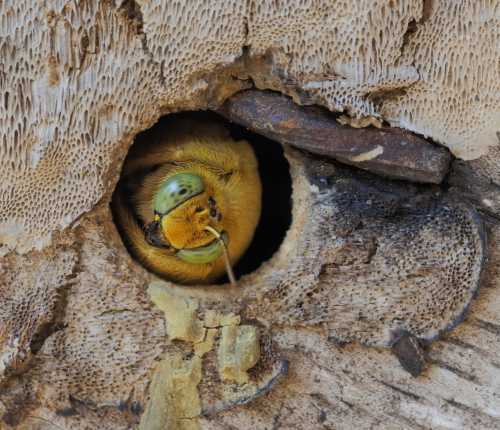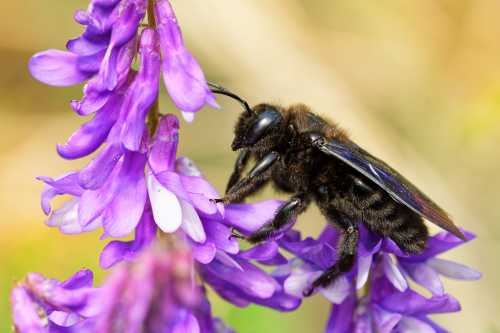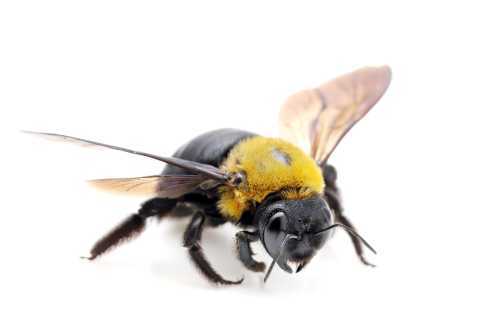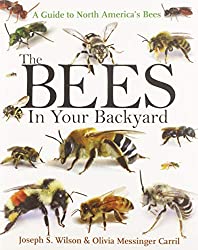10 Carpenter Bee Facts
Large carpenter bees are beautiful, gentle bees.
Here are 10 interesting facts (and 'FAQs') providing a snapshot into the world of this lovely group of bees, along with links to further information.
10 Facts (And FAQs) About Large Carpenter Bees
 Valley Carpenter Bee (Xylocopa varipuncta) male at a nest entrance. This species is found in Southwestern USA and Mexico.
Valley Carpenter Bee (Xylocopa varipuncta) male at a nest entrance. This species is found in Southwestern USA and Mexico.
1. What is the scientific name for large carpenter bees?
The scientific name for the carpenter bee genus is Xylocopa. Xylocopa is the Greek word for "wood worker"1. This is a fitting name for a bee that chews into and creates its nest tunnels in wood.
Carpenter bees have very strong mandibles (jaws/mouthparts) for chewing wood.
However, carpenter bees rarely chew painted or varnished wood2.
2. How many carpenter bees are there in the world?
Over 500 Xylocopa species are known throughout the world, most of them found in tropical regions1.
3. Are there other carpenter bees?
Large carpenter bees (Xylocopa) are related to another genus of very tiny bees called Ceratina.
In contrast to the large, burly Xylocopa genus, Ceratina are typically about 0.1inch (2.5mm) in length1. No surprise then, that Ceratina are commonly known as 'small carpenter bees'.
4. Pollination
Large carpenter bees are able to buzz pollinate.
5. Which important crops are pollinated by large carpenter bees?
In various regions of the world, large carpenter bees are important pollinators, especially in Brazil where they pollinate passion fruit and Brazil nuts; Australia, where they are used in greenhouses to pollinate tomatoes; and the Middle East, where they pollinate cotton1.
6. Male carpenter bees
Male large carpenter bees cannot sting, although they may seem a little intimidating when they investigate the presence of humans (and other 'intruders') around nest sites, they are actually harmless!
7. The largest carpenter bee in the world
The largest carpenter bee in the world is probably Xylocopa latipes3, the 'Tropical Carpenter Bee', also known as the 'Giant Bornean Bee'.
This species is found in Southeast Asia, and was first described by English entomologist, Dru Drury in 1773.
It has a wingspan of 2.63 inches long (60mm)3, and a body length of 1.1 - 1.32 inches (30 - 35mm)4.
The species Xylocopa tenuiscapa found in South and Southeast Asia is recorded as having a body length in a similar range4.
8. How painful are carpenter bee stings?
The Giant Bornean Bee was the bee with the most painful sting of the sample of bees included in a study comparing pain from insect stings, according to the Schmidt Sting Pain Index.
See - Can Carpenter Bees Sting?
However, the species is not aggressive, and the pain from its sting only measured about halfway up the pain scale.
 Violet Carpenter Bee (Xylocopa violacea) on Tufted Vetch Plants (Vicia cracca)
Violet Carpenter Bee (Xylocopa violacea) on Tufted Vetch Plants (Vicia cracca)9. Eggs
Carpenter bee females lay 7 -8 large eggs in a nest per year.
It is sometimes written that carpenter bees have the largest eggs of all insects, but it depends how 'largest' is defined - see Carpenter Bee Eggs.
10. Nest parasites
A parasite wasp species (Polochrum) attacks nests of large carpenter bees.
The wasp lays eggs in the nests of Xylocopa species, which then develop further into larvae then very large, dark cocoons - see Carpenter Bee Eggs.
References
1. Wilson & Messinger-Carril; The Bees In Your Backyard, Princeton University Press 2016.
2. E.E. Grissell, Florida Department of Agriculture and Consumer Services, Division of Plant Industry; Malcolm T. Sanford (retired) and Thomas R. Fasulo (retired), University of Florida. July 1999. Reviewed: December 2017. Featured Creatures, University of Florida Entomology & Nematology.
3. Bec Crew 2018, 'This huge black bee is a gentle giant', www.australiangeographic.com.
4. Boontop Y, Malaipan S, Chareansom K (2008) Large carpenter bees in Thailand and biology of Xylocopa nasalis (Westwood). Thailand Natural History Museum Journal 3: 5–15.
If you found this page helpful or interesting, I'd really be grateful if you would share it with others - if not this page, perhaps another, such as Gardening For Bees.
Thank you so much :) .


